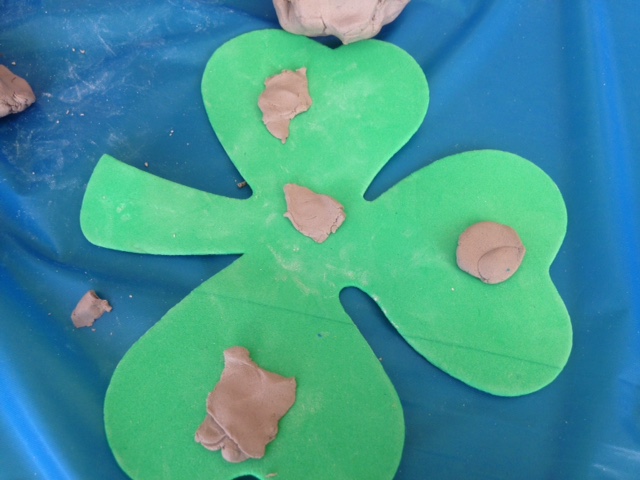Tell the story:
It was a cold and sunny morning and the children at We are Family child care center were indoor for a couple of hours due to the cold weather . Some children were building towers using the blocks. The ECA in the class was monitoring the children in the bathroom. The RECE in the class was implementing a math activity with four children at the yellow circle table. Tanvi and Sam were both playing in the kitchen area.The two children saw me setting up the table with my clay materials. They walked towards me and said, ” Ms. T can I help you with the set-up?” Tanvi and Sam placed the table cloth on the table. I put sensory items and loose parts displayed on the circle table for the children to pick and choose their items. 
The children were excited to play with the clay and loose parts that were provided to them. Some of the sensory items that were placed on the table were a few craft and beach items. I gathered a few children to join me at the circle table including Tanvi and Sam. I gave a small chunk of clay per child and allowed the children to freely engage.

Tanvi rolled her clay into a ball then flatten in with a rolling pin and I asked her ” What are you doing? are you making food?” She said, ” I’m making a snow man and adding a stick at the bottom to be his legs”.
Tanvi and Sam were sharing their work and suggesting ideas of what to make. As Sam suggested she said, ” Let’s make a sandcastle and put it on top of this red toy”. Tanvi made it into a ball and added a stick on top and said, ” Look! Sam this is my flag”.

The teacher was observing the children’s creation and asked open-ended questions to get the children thinking. The teacher said to Tanvi, “How does the clay feel? Is it soft? or hard?”. She responded saying, ” I love the clay it’s soft and i feel lucky for getting the chance to play with it today”.
Reflect on the story:
When Tanvi and Sam came to the table after they noticed I had set, they both had smiles on their faces. They enjoyed clay in the past whenever the teacher had the clay center open twice a week. The children were eager to participate and get their hands messy when they saw clay in front of them. Tanvi and Sam seemed to engage in positive conversations about their process of artwork. Before interacting with clay, the children noticed that there were familiar sensory items on the table. They seemed to say aloud their favorite items to play with whenever there is a sensory activity. When they noticed that there are loose parts that they find in their daily environment, they were excited to include it in their artwork. The children had a great amount of control over their hand movements and kneading the clay (Fox, Schirrmacher, 2015). The physical space was heavily shared and equally used by all the children. There was enough space for all the children at the table. Clay creates a social interaction with peers and children engage in conversation with enthusiasm. Tanvi and Sam increased their social bond through the activity and shared their experiences with one another. Clay can be express through many emotions, thoughts or feelings. I provided a fair amount of materials and they got to experiment with items that may not have been traditionally for clay. Sticks, rocks, and leaves are a great way to explore texture. When Tanvi and Sam shared materials like rocks, sticks, and leaves they are learning to share. They are learning about perspective taking. It seemed that they connected more on a greater level through the participation of activities and being in a social group environment.
Next steps and further plans:
I should include water and brown paper in my experiment to see how the children will react to the new changes that are being extended to it. To make further changes I will include all the children then limiting the amount that can be seated for my experience. By including a large group would create more interaction and social bonding with others. The children will create a sense of belonging, expression, well-being, and engagement when physically handling clay in their hands. The children can be creative in so many ways by making, exploring, feeling or discovering new ideas that can be brought to life. In general, clay is a child-centered activity because the children can freely do whatever they wish with it. They are not being rushed, directed or forced to do a specific thing with their clay. For example, when I was implementing this experience with the children I allowed the children to engage with the materials provided. The only thing I did was suggesting ideas of what they can build and these suggestions were considered to the children who were interested to listen. Next time, I would ask for the children’s suggestions as well and what they prefer to do when they have clay.




